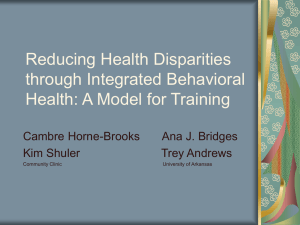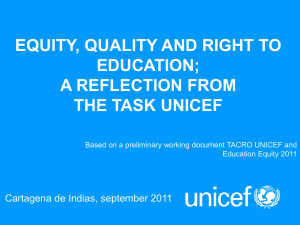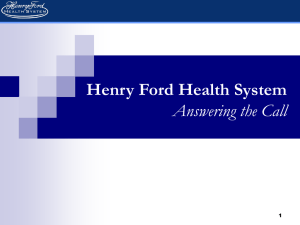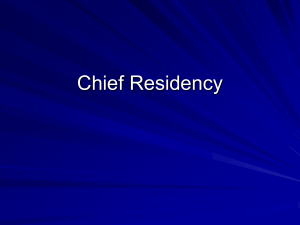additional residency health equity training programs
advertisement
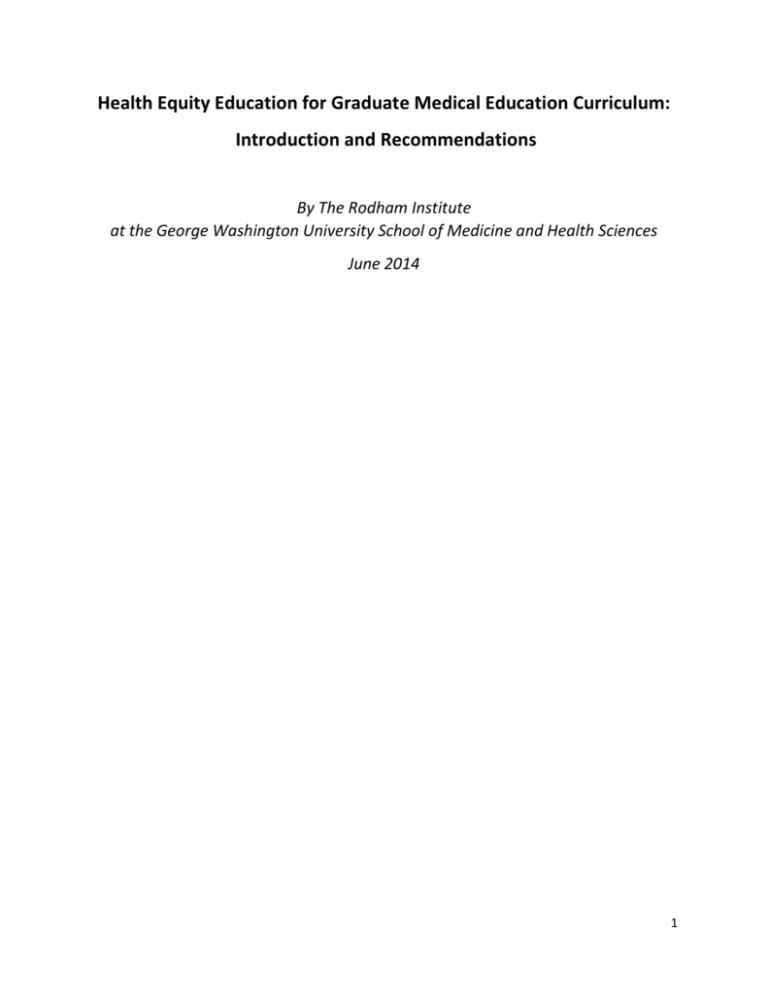
Health Equity Education for Graduate Medical Education Curriculum: Introduction and Recommendations By The Rodham Institute at the George Washington University School of Medicine and Health Sciences June 2014 1 Summary and Recommendations Health equity is an increasing area of focus within academic medical centers. Health equity education programs for medical trainees, however, are more likely to be directed at the medical school level, as opposed to Graduate Medical Education (GME) level. An exception is seen with many Family Medicine Residency programs, as well as those Internal Medicine and Pediatrics residency programs that contain a track in “community health,” “underserved medicine,” “rural health,” “urban health,” and/or “primary care” – all of which tend to focus heavily on health equity-related training. Other residency programs, such as General Surgery, Emergency Medicine, Neurology, OB/GYN, are less likely to incorporate health equity training into their curriculum. This presents an opportunity to develop novel and innovative health equity training aimed at ALL providers, not only those in primary care fields. The following document provides an overview of existing health equity educational programs at residents programs in the U.S. While these programs are highly diverse, several trends and themes emerge, which may be helpful in guiding the George Washington University health equity education efforts. Broadly speaking, health equity education may be divided into the three domains of “Knowledge, Skills, and Attitudes”: Knowledge: Fundamental knowledge about what types of health disparities exist both nationally and locally, the driving factors behind these disparities, and methods for addressing them Skills: Cross-cultural and interpersonal communication, empathy and humanism Attitudes: Creating opportunities for people of racial/ethnic minority background to pursue careers in healthcare, and motivating those in training to pursue careers in fields (e.g. primary care) and settings (e.g. community-based) that will address health disparities The following principles and approaches appear to be key aspects of successful curricular changes: Interdisciplinary learning (i.e. implementing healthy equity training for residents in conjunction with other learners, such as nursing and public heath students) Community-based learning (i.e. working with community partners to develop sustainable, mutually beneficial partnerships that will promote health equity education) Longitudinal learning (i.e incorporating health equity education in a sustained, longitudinal fashion that will enhance learning and community engagement) A review of existing residency program health equity training reveals several potential options, or “building blocks” for introducing a comprehensive health equity training program into GW’s GME programs. These may include both required elements for all residents, as well as enhancing opportunities for health equity training for those with a special interest in this area. 2 Note that the Underserved Medicine and Public Health Concentration in the Internal Medicine Residency is an outstanding example of health equity training already in progress for select GW residents, creating a valuable foundation for future efforts. In addition, there are numerous available resources to provide health equity curricular activities, including SGIM’s “A Train the Trainer’s Guide: Health Disparities Education.” A model curriculum at GW may include the following components: Health Equity Orientation – A required lecture or course for new residents from all specialties to provide an introduction to underserved neighborhoods in DC, resources for caring for patients living in these communities, and skill-building activities for providing equitable care to these patients. o E.g. University of Oklahoma: An Experiential Community Orientation to Improve Knowledge and Assess Resident Attitudes Toward Poor Patients o E.g. Utilize content from existing health disparities courses at GW Incorporation of health equity teaching into existing educational settings for all residents o Conduct Health Equity Noon Conferences, Grand Rounds, and/or Morning Report for all residency programs, focusing on high-yield topics applicable to all specialties, such as “An introduction to community health centers and related resources in DC”, or “Improving transitions of care for underserved patients.” o Faculty training to help incorporate health equity principles into clinical teaching “Applied health equity” volunteer opportunities o Expand access to, and encourage participation in volunteering activities that help to improve the health of underserved communities, while also potentially improving resident attitudes towards underserved care. For example, GW may develop a database of volunteer activities tailored to utilize the skill sets of residents, while also providing “hands on” healthy equity education for residents. Health equity research and quality improvement o Expand opportunities and support resident research and QI projects related to health equity. These projects may be used for the required Scholarly Project o Identify and support faculty mentors with interest in health equity projects Health Equity Track/Pathway/Certificate–Educational opportunities for residents with a special interest in health equity o Utilize GW’s highly successful Underserved Medicine and Public Health Concentration as a foundation for other health equity-related training opportunities. o Consider adoption of the UMPH concentration model to other residency programs. 3 o Implement an “Interdisciplinary Health Equity Certificate” program for residents, as well as learners from other disciplines, such as Nursing, Public Health, and Business o Offer “Internal Medicine and Health Equity” Residency program, which may include an M.P.H. degree option, and expanded training time (e.g. Brigham’s Residency in Global Health Equity and Internal Medicine) The following table presents the multiple different options for implementing health equity educational curricula: Options for Implementation of Residency-Level Health Equity Training Training methods Didactic - classroom (new courses/seminars +/- existing public health courses) Didactic – online Training duration Integrated within current training Extension of current training time Work with single of multiple community partner No formal community Community partnership Experiential/communitybased 4 partnerships Discrete vs. longitudinal Rotation/elective Longitudinal Participants Single specialty (e.g. Internal Medicine) Multi-specialty (e.g. surgery, EM, etc.) Interdisciplinary (e.g. nursing, law, public health, business) Outcome Pathway/Track/Program Certificate Joint MPH Research Required research component No research required Implementation of this model curriculum would achieve the following: Provide health equity training for all residents, not just primary care fields. This is a novel and innovative approach, and would help to expand skill sets necessary to all physicians to care for underserved patients. Expand on GW’s successful UMPH program, thus utilizing existing infrastructure, and helping to promote cross-specialty communication and partnership Promote interdisciplinary collaboration, strengthen research capacity, and improve community partnerships Clarification and Definitions The terminology related to health disparities and health equity education is varied. There are many words and phrases that reflect a similar meaning or emphasis. These include, but are not limited to health equity, health disparities, community health, underserved medicine, urban health, rural health, public health, and population health. For the purposes of this document, I have taken these terms to be largely equivalent EXCEPT for public health and population health, as these terms don’t always imply a focus on health disparities. Background There is little published research on GME health disparities training. A recent review by Hasnain and colleagues reveals only 16 published articles on this topic.1 The vast majority of the studies are from internal medicine, pediatrics or family medicine. About half of the programs included a longitudinal training component, 44% of programs offered “block experiences”, and one program used a one-time Internet-based module. One-quarter of the programs included a research project. Based on the review of existing programs, the authors suggest incorporation of the following elements into curriculum planning for GME health disparities training: a. “Clearly-stated desired attitudes, values and competencies for learners 1 Hasnain M, Massengale L, Dykens A, Figueroa E. Health disparities training in residency programs in the United States. Fam Med. 2014 Mar;46(3):186-91. 5 b. Multimodal and longitudinal didactic and experiential learning activities, including training in population-based health and community-based participatory research c. Rigorous evaluation methodologies, both formative and summative, and follow-up of graduates’ careers to assess long-term impacts d. d. Faculty development—professional development of residency faculty to ensure quality of developed curricula” While there is little published literature related to health equity GME training, academic medicine is well-positioned to play an important role in addressing health equity through curricular changes. As Cavanaugh and Rajput write: “Academic medicine can play an important role in the reduction of health care disparities by formally addressing the subject in the medical education curriculum. The majority of medical schools and teaching hospitals are located in diverse cultural, racial, and ethnic urban communities that enable students and residents to learn directly how their patients’ beliefs, language, and other cultural factors create obstacles with the health care system. The academic medicine-community partnership model with cross-cultural encounters, using the principles of community assessment and community-based participatory research, can offer a rich learning experience in health care disparities.”2 GENERAL RESOURCES ON GME HEALTH EQUITY EDUCATION 2 Maldonado ME, DuBose TD, Nelson C. Role of graduate medical education in addressing health care disparities: A multi-pronged approach is needed. Academic Internal Medicine Insight. 2013;11(4):10-11. Cavanaugh SK, Rajput V. Health care disparities: A bimodal approach to curriculum. Academic Internal Medicine Insight. 8(4):4-7. This article provides an overview of IOM recs related to teaching health disparities to providers, and advocates for a way incorporate these recs into existing ACGME “core competencies” for med students and residents. A train the trainers guide: health disparities education (SGIM) – an extensive overview of how educators can approach/prepare for health disparities education interventions The accompanying journal article: Ross PT, Wiley Cené C, Bussey-Jones J, Brown AF, et al. A strategy for improving health disparities education in medicine. J Gen Intern Med. 2010 May;25 Suppl 2:S160-3. Glick SB, Fernandez L, Irby DM, Harleman E, Fernandez A. Teaching About Health Care Disparities in the Clinical Setting J Gen Intern Med. 2010 May; 25 Suppl 2:S95-101. – academic article proposing a model for incorporating health disparities teaching into clinical Cavanaugh SK, Rajput V. Health care disparities: A bimodal approach to curriculum. Academic Internal Medicine Insight. 8(4):4-7. 6 scenarios Anjani T. Reddy, Sonia A. Lazreg, Robert L. PhillipsJr, Andrew W. Bazemore, and Sean C. Lucan (2013) Toward Defining and Measuring Social Accountability in Graduate Medical Education: A Stakeholder Study. Journal of Graduate Medical Education: September 2013, Vol. 5, No. 3, pp. 439-445. Mark L. Wieland, Thomas J. Beckman, Stephen S. Cha, Timothy J. Beebe, Furman S. McDonald, (2011) Residents' Attitudes and Behaviors Regarding Care for Underserved Patients: A MultiInstitutional Survey. Journal of Graduate Medical Education: September 2011, Vol. 3, No. 3, pp. 337-344. 7 RESIDENCY HEALTH EQUITY TRAINING: EXEMPLAR PROGRAMS Children’s Hospital Los Angeles Pediatric Residency IMPACT Project Track “The IMPACT program is designed for those who are more interested in an in-depth and focused experience, which involves either a community-based intervention or policy work. Residents on the IMPACT track have dedicated time during all three years of residency to work on development and implementation of a single project. Residents can choose from three areas of emphasis: Community Health Track, Global Health Track, Quality Improvement Track. During this time they work closely with IMPACT mentors to perform a needs assessment, design and implement their study or intervention, arrange meetings with key community partners and complete grant applications. At the end of the project period, residents will evaluate their project in a research framework and present their findings at an academic meeting and Grand Rounds. IMPACT interns are required to attend a monthly noon conference series separate from the general residency program, focused on child health advocacy, community health, research skills and leadership. IMPACT residents and mentors also attend evening events 3 times a year which include a guest speaker and dinner, with topics such as child health coverage and access.” Brigham and Women’s Residency in Global Health Equity and Internal Medicine “A graduate medical education program in health equity was developed at Brigham and Women's Hospital based on a review of existing literature and on a survey of junior faculty who have had informal health disparities experience. The Howard Hiatt Residency in Global Health Equity and Internal Medicine was developed as a four-year program to provide intensive training in internal medicine and health disparities. Participating residents are matched with a mentor who has clinical and research experience in the field of global health. In addition to a series of didactic teaching sessions and longitudinal seminars that focus on issues of global health equity, residents take graduate level courses in epidemiology, health policy, ethics, and medical anthropology. Residents also carry out an independent research project in a geographic area that suffers from health disparities. Two residents are selected for training per year. Participating faculty are multidisciplinary and come from diverse Harvard-affiliated institutions. Graduate medical education in the United States with a focus on health equity is lacking. It is hoped that the novel training program in health equity for internal medical residents developed at Brigham and Women's Hospital can serve as a model for other teaching hospitals based in the United States.”3 UNC Interdisciplinary Certificate in Health Disparities - The University of North Carolina at Chapel Hill Program on Ethnicity, Culture and Health Outcomes (ECHO) explores new and innovative partnerships and collaborative opportunities to improve the health of North Carolina communities by eliminating racial and ethnic health disparities through its multidisciplinary and culturally sensitive research, education and training initiatives. ECHO is committed to educating and training a cadre of students and working professionals to expand their knowledge of health 3 Furin J, Farmer P, Wolf M, et al. A novel training model to address health problems in poor and underserved populations. J Health Care Poor Underserved 2006;17(1):17-2 8 disparities and to equip them with the skills to work towards eliminating health disparities through research, community action, public health practice, and/or practice. The certificate program requires completion of 10 credit hours towards the certificate: o o o o o o o o The required three-credit course: Understanding and Addressing Health Disparities in the United States The required one-credit Interdisciplinary Seminar in Health Disparities At least one additional course from the Health Disparities Certificate Curriculum A series of courses from those within the Health Disparities Curriculum (six total credit hours). Attend certificate program’s academic progress meetings held each semester Attendance at four monthly ECHO Health Disparities Seminars over the course of each academic year Active participation in the online discussion board Completion of the certificate program’s exit survey. GW Underserved Medicine and Public Health Scholars The Underserved Medicine & Public Health (UMPH) Concentration is designed for residents interested in careers in public health and serving the underserved. This two-year longitudinal program includes: o caring for patients at a local community health center for a second continuity clinic, o evening seminars on public health topics, o designing and performing a public health practicum project on a topic of interest to you 9 ADDITIONAL RESIDENCY HEALTH EQUITY TRAINING PROGRAMS Teaching Health Center Graduate Medical Education Consortium (The Wright Center) “ The Wright Center’s strategically designed and community-based residency experience prepares our graduates to be leaders in future primary care practices and subspecialty fellowships in any geographic location where the relationship between doctor and patient can be developed to ensure better health outcomes.” Montefiore Primary Care and Social Internal Medicine “The core curriculum begins with an introductory month of Medical Spanish and Community Medicine seminars early in the PGY-I year, and over the next three years features required and selective courses in significant topics in General Internal Medicine and Community and Social Medicine. The courses are generally composed of bi-weekly two hour seminars, each of which requires considerable reading and pre-seminar problem-solving…All PC/SM residents are expected to complete an independent primary care or community medicine project during the course of residency training. The aim of the project is to develop basic research skills by investigating an area of interest in healthcare, healthcare delivery, and/or community advocacy.” OHSU GIM and Central City Concern “social medicine” partnership “OHSU and Central City Concern (CCC) have joined together to form an innovative ‘social medicine’ partnership that places OHSU Internal Medicine resident physicians in safety net clinics where they are trained by OHSU General Internal Medicine & Geriatrics faculty and CCC staff to meet the medical needs of people who are homeless or recovering from addictions.” UC-Davis TEACH program “Started in 2005, the Transforming Education and Community Health (TEACH) Program Track is a highly successful primary care training track for residents interested in caring for the medically underserved and becoming leaders in academic General Internal Medicine. The long term goal of the TEACH Program is to improve access to high quality health services by training General Internal Medicine physicians who provide well-coordinated, evidence-based, culturally humble care to underserved adults. In partnership with the County of Sacramento Department of Health and Human Services, this community-based collaborative aims to reducing health disparities and increasing the number of primary care physicians in medically underserved communities.” University of Chicago EM Residency health disparities opportunities This program offers several health opportunities for involvement in work that contributes to addressing health disparities, including Medical Spanish coursework, quality improvement projects with community organizations, a Community Health Orientation Day, as well as several volunteering and elective opportunities. 10 Hopkins Urban Health Primary Care Track “The Johns Hopkins Urban Health Internal Medicine Primary Care Leadership Track (UHT), the primary care track of the Osler Medical Residency, trains residents to be primary care leaders who improve the health of vulnerable, urban populations. Caring for vulnerable patients who live in urban settings requires a willingness to pioneer alternative care delivery models and a desire to master additional patient care, medical knowledge ( including a nuanced understanding of the social determinants of health), communication, practice-based learning, professionalism, and inter-professional teamwork skills--including collaboration with community health workers, co-training with nurse practitioner students, and community outreach and advocacy.” UNC Family Medicine Residency – Underserved Track “For residents seeking a more in-depth experience with their continuity experience at a Federally Qualified Health Center, and the opportunity to work with a higher volume of Spanish speaking patients, UNC Family Medicine offers the Underserved Track. The Underserved Track is an exceptional opportunity for residents interested in a career focused on the care of underserved populations, engagement in community health, and innovation and leadership in health care delivery. The Underserved Track is designed for residents looking to enhance their competency in caring for diverse patient populations that have often experienced significant disparities in health. Residents pursuing the underserved track will gain a deeper knowledge of the social determinants of health and explore potential remedies that address these issues on a local, regional and national scale. Residents in the Underserved Track participate in our core residency program and are exposed to identical curriculum and rotations as all UNC Family Medicine residents. However, they will have their continuity clinic experience in a rural Federally Qualified Health Center (instead of the UNC Family Medicine Center) that serves a large Spanish speaking population (see below). In addition, residents in the Underserved Track are required to participate in the Area of Concentration in Caring for the Underserved.” UIC Family Medicine Residency Health Disparities Scholars Program “… a new grant funded initiative… spanning three years of residency training. It is designed to prepare residents to lead in providing health services in areas of unmet need. The HDSP will engage residents in educational experiences that will enable them to acquire core attitudes, values and competencies related to providing high quality, patient-centered, culturally appropriate care to all patients…Learners will participate in clinical work, didactics, communitybased experiences, and scholarly work, longitudinally, across the three years of residency training. These activities will take place at Mile Square Health Center, the FQHC affiliated with University of Illinois, at other affiliated sites and may include international locations. Many Global Health and Health Equity residency programs/tracks: 11 o o o A Novel Training Model to Address Health Problems in Poor and Underserved Populations…. The Howard Hiatt Residency in Global Health Equity and Internal Medicine is a four-year program to provide intensive training in internal medicine and health disparities. VCU Internal Medicine Residency Program Global Health and Health Disparities Residency Pathway Penn Internal Medicine Residency Global Health Equities Track 12 OTHER HEALTH DISPARITIES RESOURCES/PROGRAMS IN THE DC REGION: There are numerous academic institutions in the greater DC area, who may be potential collaborators in efforts to expand GW GME health equity training. They include: University of Maryland Comprehensive Center for Health Disparities Research, Training and Outreach http://medschool.umaryland.edu/p60/ Hopkins Center for Health Disparities Solutions http://www.jhsph.edu/research/centers-and-institutes/johns-hopkins-center-for-healthdisparities-solutions/about_us/ Georgetown Center for Health Equity – Research, Implementation, and Teaching (CHERITH) https://nhs.georgetown.edu/research/cherith Georgetown Institute to Reduce Health Disparities http://healthdisparities.georgetown.edu/ DC-Baltimore Research Center on Child Health Disparities http://healthsciences.howard.edu/education/schools-and-academics/medicine/research/childhealth-disparities University of Virginia School of Medicine Center on Health Disparities http://www.medicine.virginia.edu/community-service/centers/health-disparities/home-page Children’s National Health Disparities Research Program http://www.childrensnational.org/research/ourresearch/translationalresearch/cccr/healthdispa rities.aspx 13
